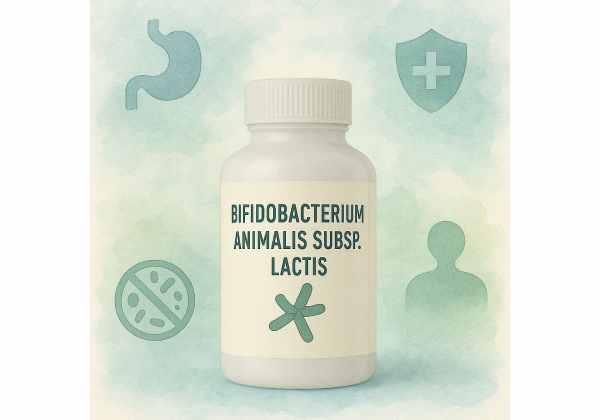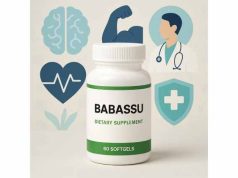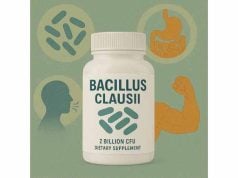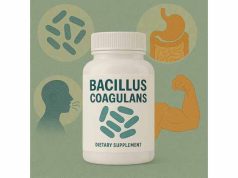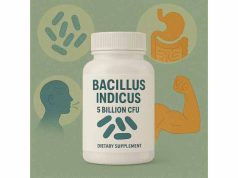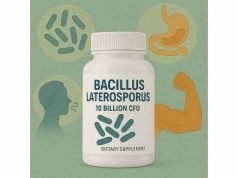Bifidobacterium animalis subsp. lactis is one of the most widely studied and utilized probiotic strains for human health. Naturally found in the digestive tracts of both humans and animals, this beneficial bacterium is now commonly included in supplements and functional foods for its wide-ranging health support. Renowned for boosting digestive balance, strengthening the immune system, and even supporting metabolic and gut-brain health, B. animalis subsp. lactis is a cornerstone of modern probiotic therapy. People seek it for relief from occasional constipation, to recover gut flora after antibiotics, and for overall immune resilience. Understanding its science, uses, dosing, and safety can help you maximize its health benefits with confidence.
Key Takeaways
- Bifidobacterium animalis subsp. lactis helps maintain gut balance, supports regularity, and aids recovery after antibiotics.
- Evidence shows benefits for immune support, lactose digestion, and even cholesterol management.
- This strain is considered safe for healthy adults and children, with rare and mild side effects.
- For best results, choose high-quality, well-labeled supplements and use consistently as part of a gut-friendly lifestyle.
- Always consult your healthcare provider if you are immunocompromised, pregnant, or managing serious health conditions.
Table of Contents
- Introduction to Bifidobacterium animalis subsp. lactis and Its Unique Role in Human Health
- The Science Behind Bifidobacterium animalis subsp. lactis: Mechanisms of Action and Biological Impact
- Clinically Proven Benefits and Practical Uses of Bifidobacterium animalis subsp. lactis
- Comprehensive Safety Profile, Side Effects, and Interactions of Bifidobacterium animalis subsp. lactis
- Dosage Recommendations, Best Usage, Timing, and Forms of Bifidobacterium animalis subsp. lactis
- Frequently Asked Questions About Bifidobacterium animalis subsp. lactis
Introduction to Bifidobacterium animalis subsp. lactis and Its Unique Role in Human Health
Bifidobacterium animalis subsp. lactis is a probiotic strain with a remarkable reputation for supporting digestive, immune, and metabolic wellness. As a member of the Bifidobacterium genus—a group of bacteria naturally inhabiting the human large intestine—B. animalis subsp. lactis stands out for its unique resilience, versatility, and effectiveness in clinical research.
What is Bifidobacterium animalis subsp. lactis?
- It is a subspecies of Bifidobacterium animalis, distinguished by its robust ability to survive manufacturing, storage, and the acidic environment of the stomach, reaching the colon alive and active.
- Notable strains include BB-12®, DN-173 010, HN019, and others, each with specific, research-backed benefits.
- It is commonly found in both supplements and functional foods, such as yogurts, kefirs, and fortified beverages.
How Does Bifidobacterium animalis subsp. lactis Differ from Other Probiotics?
- Its unique genetic profile allows it to digest a wider range of dietary fibers and prebiotics (plant-based fibers that nourish beneficial bacteria).
- B. animalis subsp. lactis is known for its ability to adhere to the intestinal wall, helping to outcompete unwanted microbes and maintain a stable gut environment.
- It is more resistant to stomach acid and bile salts than many probiotic strains, which improves its survival rate and effectiveness.
Why Is Bifidobacterium animalis subsp. lactis Important for Health?
- Restores and Maintains Digestive Balance: By replenishing beneficial bacteria, it promotes healthy digestion, regularity, and comfort, especially after antibiotic use or illness.
- Supports Immune Defense: It helps “train” the immune system to recognize threats and respond appropriately, which can lead to fewer sick days and less inflammation.
- Metabolic and Cardiovascular Effects: Research links B. animalis subsp. lactis to improved cholesterol levels, blood sugar balance, and even support for healthy weight management.
- Lactose Digestion: This probiotic can enhance the breakdown of lactose, making dairy foods easier to tolerate for those with mild lactose intolerance.
Where Does Bifidobacterium animalis subsp. lactis Come From?
- First isolated from both dairy products and the intestines of healthy mammals, this strain is now produced in controlled, high-quality fermentation facilities.
- While some fermented foods naturally contain B. animalis subsp. lactis, the most reliable way to supplement it is through standardized probiotic capsules, powders, or functional dairy products.
Who Might Benefit Most from Bifidobacterium animalis subsp. lactis Supplementation?
- Individuals recovering from antibiotics or digestive disturbances
- People with occasional constipation or irregularity
- Those seeking immune support, especially during cold and flu season
- Anyone aiming for better digestive comfort, metabolic wellness, or support with lactose digestion
Probiotics like B. animalis subsp. lactis are most effective when paired with a gut-friendly lifestyle, including plenty of fiber, regular activity, and minimal processed foods.
The Science Behind Bifidobacterium animalis subsp. lactis: Mechanisms of Action and Biological Impact
Understanding how Bifidobacterium animalis subsp. lactis works can help you appreciate why it’s so highly valued among probiotics. Its benefits stem from several key scientific mechanisms that collectively improve gut health and whole-body wellness.
1. Advanced Fermentation of Dietary Fiber and Prebiotics
B. animalis subsp. lactis excels at fermenting complex plant fibers, including inulin, fructooligosaccharides (FOS), and resistant starches. This process produces short-chain fatty acids (SCFAs)—mainly acetate and propionate.
- Why SCFAs matter: They provide energy for colon cells, lower the gut’s pH (making it harder for pathogens to thrive), and have anti-inflammatory and metabolic effects.
- Gut barrier protection: These acids help strengthen the mucosal lining, reducing the risk of “leaky gut” and keeping toxins and microbes from entering the bloodstream.
2. Crowding Out Harmful Bacteria
B. animalis subsp. lactis attaches to the gut wall and uses up nutrients that would otherwise feed potentially harmful microbes. It also produces natural antimicrobial substances, further protecting the gut environment.
- Competitive exclusion: By outcompeting “bad” bacteria, this probiotic supports a more stable, healthy microbiome.
3. Immune System Support and Modulation
- Immune “training”: This probiotic interacts with gut-associated lymphoid tissue (GALT), which houses up to 70% of the immune system.
- Anti-inflammatory effects: It increases regulatory T cells (which keep immune responses in check) and lowers pro-inflammatory signals, potentially reducing the risk of allergies and autoimmunity.
4. Support for Regularity and Bowel Comfort
B. animalis subsp. lactis improves the frequency, consistency, and ease of bowel movements—especially helpful for those struggling with occasional constipation or irregularity.
- Transit time: By enhancing intestinal motility and water absorption, it supports gentle, regular elimination without harsh stimulants.
5. Impact on Lactose Digestion
Some strains of B. animalis subsp. lactis produce lactase, the enzyme that breaks down lactose in dairy. This helps reduce bloating, discomfort, and diarrhea in those with lactose intolerance.
6. Metabolic and Cardiovascular Health Effects
Research indicates this probiotic:
- May lower LDL (“bad”) cholesterol and total cholesterol
- Supports healthy blood sugar balance
- Plays a role in healthy weight management through gut-brain axis signaling and hormone modulation
7. Gut-Brain Axis and Mood Support
Through SCFA production and inflammation reduction, B. animalis subsp. lactis may indirectly support mood balance, stress resilience, and cognitive clarity.
Summary Table of Key Mechanisms
| Mechanism | Impact |
|---|---|
| Fermentation of fiber/prebiotics | SCFA production, gut barrier integrity |
| Outcompeting harmful bacteria | Reduces pathogen colonization |
| Immune system modulation | Lower inflammation, stronger immunity |
| Lactose digestion support | Reduces symptoms in lactose intolerance |
| Metabolic regulation | Supports cholesterol, glucose, weight |
| Gut-brain axis effects | May influence mood and stress response |
B. animalis subsp. lactis acts on many fronts, making it one of the most comprehensive probiotics for daily wellness.
Clinically Proven Benefits and Practical Uses of Bifidobacterium animalis subsp. lactis
Bifidobacterium animalis subsp. lactis is supported by robust clinical research for a variety of health benefits. Let’s explore the most important, evidence-based applications and how to use this probiotic for real-world wellness.
1. Promoting Digestive Regularity and Comfort
- Clinical studies show this probiotic significantly improves stool frequency, consistency, and overall comfort, especially in those with mild to moderate constipation or irregularity.
- Benefits are typically noticeable within 1–2 weeks of daily use.
2. Enhancing Recovery After Antibiotics
- B. animalis subsp. lactis can help replenish beneficial bacteria lost during antibiotic treatment, reducing the risk of diarrhea and promoting quicker microbiome restoration.
3. Supporting Immune Health
- Regular supplementation is linked with fewer colds and infections, particularly in children and adults exposed to high-stress or crowded environments (like schools, offices, or travel).
- Some strains help balance immune responses, which may be beneficial for mild allergies or inflammation.
4. Lactose Intolerance Relief
- This probiotic is commonly used in yogurts and dairy-based supplements to help those with mild lactose intolerance digest dairy more comfortably and with fewer symptoms.
5. Improving Metabolic Markers
- Evidence shows that regular supplementation may help lower total cholesterol, LDL cholesterol, and even improve blood sugar control—especially when used alongside a healthy diet and lifestyle.
6. Gut-Brain and Mood Support
- While research is still early, some studies report improved mood, less anxiety, and better cognitive performance in people supplementing with B. animalis subsp. lactis, likely due to its anti-inflammatory and gut-brain axis effects.
7. Real-World Use Cases
- Digestive Upset: After travel, illness, or dietary changes
- Family Wellness: For children, parents, and seniors to support resilience during cold and flu season
- Daily Maintenance: As a “base” probiotic for ongoing gut and immune health
Summary Table of Key Benefits
| Health Goal | How B. animalis subsp. lactis Helps | Evidence Level |
|---|---|---|
| Digestive regularity | Improves frequency and comfort | Strong (clinical trials) |
| Post-antibiotic recovery | Restores microbiome, reduces diarrhea | Strong (clinical trials) |
| Immune support | Reduces infections, balances response | Good (human studies) |
| Lactose intolerance | Eases digestion of dairy | Good (human studies) |
| Metabolic wellness | Lowers cholesterol, supports glucose | Moderate (pilot studies) |
| Mood and stress | Early evidence for gut-brain support | Early (pilot/observational) |
B. animalis subsp. lactis is a reliable probiotic for digestive health, immune function, and more.
Comprehensive Safety Profile, Side Effects, and Interactions of Bifidobacterium animalis subsp. lactis
Bifidobacterium animalis subsp. lactis is widely recognized as safe and well-tolerated for most healthy adults and children. Its inclusion in foods and supplements is backed by decades of use, robust research, and safety assessments by food and regulatory authorities. However, as with any supplement, it’s important to understand its safety profile, potential side effects, and situations where extra caution may be needed.
1. General Safety Overview
- Most people experience no side effects from B. animalis subsp. lactis, even at high doses used in clinical trials.
- It is classified as GRAS (Generally Recognized as Safe) in the United States and has a similar safety designation in many countries.
- The risk of serious adverse events is extremely low in healthy individuals.
2. Common and Rare Side Effects
While rare, some users may experience mild, temporary side effects as their gut adapts:
- Digestive symptoms: Mild gas, bloating, or soft stools, particularly when first starting supplementation or increasing the dose. These symptoms usually resolve in a few days as the gut microbiota rebalances.
- Other reactions: Occasionally, mild abdominal cramps or an increased urge to have a bowel movement may occur.
Severe or persistent symptoms are unusual. If you experience ongoing discomfort, it’s advisable to reduce the dose or discontinue use and consult your healthcare provider.
3. Who Should Use Extra Caution
While safe for most, certain groups should talk to a healthcare provider before starting any probiotic, including B. animalis subsp. lactis:
- Immunocompromised individuals: People with weakened immune systems (such as those undergoing chemotherapy, organ transplants, or advanced HIV/AIDS) are at increased risk for rare infections from probiotics. Though very uncommon, cases of bacteremia have been reported in immunosuppressed patients.
- Critically ill or hospitalized patients: Only use probiotics under direct medical supervision.
- Infants and young children: Some formulas are suitable for infants, but always use age-appropriate strains and consult a pediatrician.
- People with severe bowel disease or short gut syndrome: These conditions can alter the gut’s protective barriers; medical guidance is essential.
4. Allergic Reactions
- Allergies to B. animalis subsp. lactis itself are extremely rare.
- Most adverse reactions are due to inactive ingredients, fillers, or allergens (such as dairy, soy, or gluten) present in some commercial products. Always check labels carefully if you have known allergies or sensitivities.
Signs of an allergic reaction include:
- Rash, hives, or itching
- Swelling of lips, face, or throat
- Difficulty breathing
Seek immediate medical attention if you experience these symptoms.
5. Drug and Supplement Interactions
B. animalis subsp. lactis is not known to interact with most medications or supplements, but there are a few important points:
- Antibiotics: Antibiotics can reduce the numbers of probiotics in your gut. If you are taking antibiotics, separate your probiotic dose by at least 2–3 hours, or start supplementation after completing your antibiotic course.
- Immunosuppressive drugs: As with all probiotics, those taking immune-modulating medications should consult a healthcare provider.
- Multi-strain probiotic use: Taking B. animalis subsp. lactis alongside other probiotics is generally safe and may be beneficial, but high doses of multiple products can increase the risk of mild digestive side effects.
6. Supplement Quality and Contamination Risks
- Choose products from reputable manufacturers with third-party testing and clear labeling of strain (such as B. animalis subsp. lactis BB-12®, HN019, etc.) and CFU count.
- Proper storage (some strains require refrigeration) and using the product before its expiration date will help avoid loss of potency and potential contamination.
7. When to Stop Use and Seek Help
Discontinue use and seek medical advice if you experience:
- Persistent or severe abdominal pain, vomiting, or fever
- Blood in your stool or other signs of infection
- Any allergic reaction symptoms
Summary Table: Safety and Precautions
| Safety Aspect | Details |
|---|---|
| Most users | Well tolerated, minimal risk |
| Side effects | Mild gas, bloating, soft stools (rare) |
| At-risk populations | Immunocompromised, critically ill—consult MD |
| Allergies | Rare; usually due to product ingredients |
| Drug interactions | Not significant; separate from antibiotics |
B. animalis subsp. lactis is among the safest and best-studied probiotics, especially when high-quality, properly stored supplements are used.
Dosage Recommendations, Best Usage, Timing, and Forms of Bifidobacterium animalis subsp. lactis
Finding the right dose, form, and timing for Bifidobacterium animalis subsp. lactis ensures optimal benefits and minimal risk of side effects. Let’s break down the best practices, based on clinical studies, real-world experience, and expert guidelines.
1. Typical Dosage Guidelines
- Adults: Most supplements provide between 1 billion (1 × 10⁹) and 20 billion (2 × 10¹⁰) CFUs (colony-forming units) per serving. Clinical studies have shown benefits with daily doses in this range.
- Children: Pediatric products may contain lower doses, generally 1–5 billion CFUs per serving. Always use child-specific formulas and follow pediatrician guidance.
- Multi-strain blends: B. animalis subsp. lactis is often combined with other probiotic strains for broader benefits. Check the label for per-strain CFU amounts.
2. Supplement Forms
- Capsules and Tablets: The most common form, convenient for daily use.
- Powders: Can be mixed into water, juice, or soft foods—ideal for those who have trouble swallowing pills.
- Functional Foods: Found in some yogurts, kefirs, and dairy beverages (look for “live and active cultures” on the label).
- Multi-strain blends: Often paired with other Bifidobacterium and Lactobacillus species.
3. When and How to Take
- With or without food: Most research shows that taking probiotics with a meal (especially with some healthy fat) can improve survival through stomach acid. However, B. animalis subsp. lactis is resilient and can be taken at any time.
- Consistency is key: Daily, regular use at the same time each day supports optimal colonization and benefits.
- After antibiotics: For microbiome recovery, start supplementation as soon as your antibiotic course is finished, or separate doses by 2–3 hours during treatment.
4. Duration of Use
- Short-term: For acute issues (digestive upset, after antibiotics), 2–4 weeks is typical.
- Long-term: Ongoing daily use is safe and may be preferred for chronic digestive, immune, or metabolic support.
5. Maximizing Results
- Combine with a fiber-rich diet (prebiotic fibers from oats, bananas, onions, etc.) to help the probiotic thrive.
- Stay hydrated, especially if increasing fiber.
- Store according to product directions to maintain potency.
6. Adjusting Your Dose
- Increase: If you see no benefits after several weeks and tolerate the supplement well, consider increasing within the manufacturer’s recommended range.
- Decrease: If you experience ongoing bloating or discomfort, try lowering the dose or taking a brief break before resuming.
7. Choosing a Quality Product
- Look for specific strain labeling (e.g., BB-12®, HN019), guaranteed live CFUs at expiration, and third-party testing.
- Select reputable, transparent brands with a track record for probiotic quality.
Summary Table: Dosage and Administration
| User | Typical Dose | Timing | Duration |
|---|---|---|---|
| Healthy adult | 1–20 billion CFU/day | With/without food | 2–4 weeks or ongoing |
| Children | 1–5 billion CFU/day | With food | As advised by doctor |
| Post-antibiotic | 1–20 billion CFU/day | After antibiotics | 2–4 weeks |
Responsible use and proper storage help you get the best results from B. animalis subsp. lactis supplements.
Frequently Asked Questions About Bifidobacterium animalis subsp. lactis
What is Bifidobacterium animalis subsp. lactis used for?
B. animalis subsp. lactis is mainly used to support digestive regularity, recover gut balance after antibiotics, boost immune health, aid in lactose digestion, and may benefit cholesterol and metabolic wellness.
Is Bifidobacterium animalis subsp. lactis safe to take every day?
Yes, it’s considered safe for daily use in healthy adults and children. Those with compromised immunity or serious health conditions should consult a healthcare provider before starting any probiotic.
How does Bifidobacterium animalis subsp. lactis improve digestion?
It ferments dietary fiber to produce beneficial acids, crowds out harmful microbes, strengthens the gut barrier, and helps maintain regular bowel movements—supporting digestive comfort and balance.
Can Bifidobacterium animalis subsp. lactis help after antibiotics?
Yes, evidence shows it helps replenish beneficial gut bacteria, reduces risk of antibiotic-associated diarrhea, and restores microbiome balance.
Does Bifidobacterium animalis subsp. lactis interact with medications?
It does not cause significant interactions with most medicines. However, separate your probiotic dose from antibiotics by a few hours for best results, and consult your doctor if taking immunosuppressive drugs.
How long should I take Bifidobacterium animalis subsp. lactis?
For post-antibiotic recovery, 2–4 weeks is typical. For ongoing digestive or immune support, long-term daily use is safe for most people.
What foods naturally contain Bifidobacterium animalis subsp. lactis?
It’s present in some yogurts, kefirs, and dairy drinks labeled with “live and active cultures,” but supplements provide standardized, research-backed doses for targeted benefits.
Disclaimer:
The information provided in this article is for educational and informational purposes only and is not intended as a substitute for professional medical advice, diagnosis, or treatment. Always seek the advice of your physician or another qualified health provider with any questions you may have regarding a medical condition or supplement regimen. Never disregard professional advice or delay in seeking it because of something you have read here.
If you found this article helpful, please consider sharing it with friends and family on Facebook, X (formerly Twitter), or your favorite social media platform. Your support helps us create more high-quality, evidence-based wellness content. Thank you for reading, and don’t forget to follow us for the latest updates and wellness tips!


